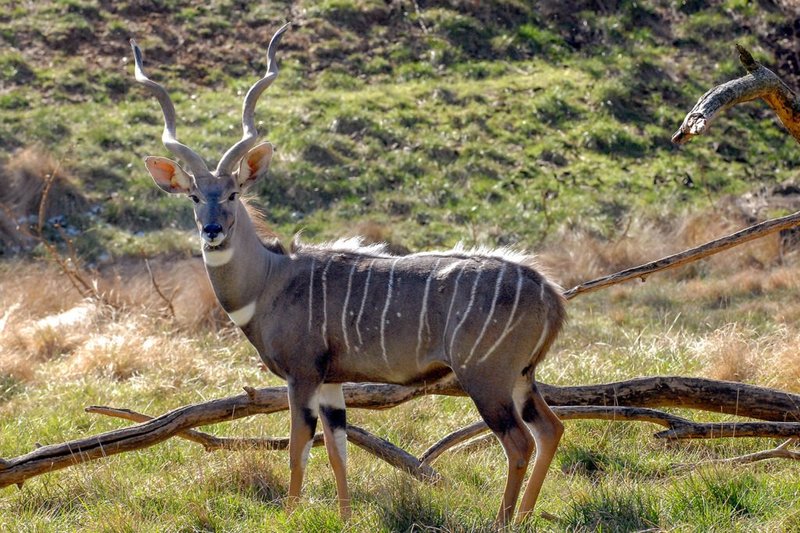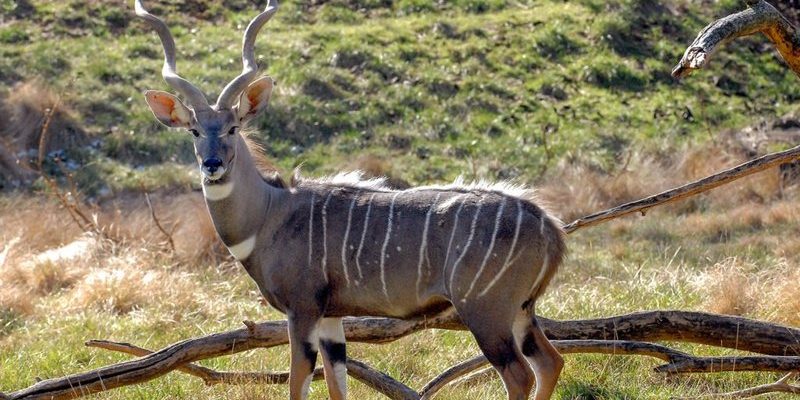
You might be wondering why we should focus on this specific animal. Well, the lesser kudu interacts with its surroundings in ways that highlight the interdependence of life. Just like a well-oiled machine, all parts must work together for everything to thrive. In this article, we’ll explore the lesser kudu’s role in its ecosystem, from its diet to its interactions with other species, and why it matters to conservation efforts.
What Is the Lesser Kudu?
The lesser kudu (Tragelaphus imberbis) is a medium-sized antelope, about the size of a deer, typically reaching heights of 35 to 45 inches at the shoulder. With its long, spiraled horns and striking blue-gray coat, it’s easy to see why this animal captivates wildlife enthusiasts. Unlike its larger cousin, the greater kudu, the lesser kudu prefers dense bush and thickets, allowing it to hide from predators.
This elusive creature is primarily solitary or found in small groups, often consisting of a mother and her young. It’s a herbivore, feeding mainly on leaves, fruits, and grasses. You can think of the lesser kudu as a nature’s gardener, nibbling on certain plants and helping to control their growth. By selectively eating vegetation, it promotes the health of the ecosystem, paving the way for diverse plant life.
The Lesser Kudu’s Diet and Its Impact on Plant Life
The lesser kudu is particularly interesting when it comes to its feeding habits. This antelope prefers to browse, which means it selectively eats certain parts of plants, like leaves and twigs. You might be asking, “How does this impact the ecosystem?” Well, by eating specific plants, the lesser kudu helps maintain a balance in the types of vegetation that thrive in its habitat.
For instance, when the lesser kudu feeds on young leaves and shoots, it allows less palatable plants to grow more freely. This browsing behavior encourages plant diversity. Ultimately, this diversity supports other herbivores and the entire food chain. In a way, the lesser kudu acts like a gardener in the wild, ensuring that certain plants don’t overwhelm the landscape, which could lead to habitat degradation.
Predator and Prey Dynamics
In the wild, every animal has its role, and the lesser kudu is no exception. It serves as prey for multiple predators, such as lions, leopards, and hyenas. This relationship is crucial for the survival of these larger carnivores. By being part of the food chain, the lesser kudu helps sustain the predator populations that rely on it for nourishment.
But here’s the thing: the lesser kudu isn’t just sitting back and accepting its fate. It has developed a variety of adaptations to avoid predators. Its excellent camouflage and ability to blend into dense bushes make it a challenging target. When threatened, the lesser kudu can flee swiftly to safety, making it a challenging meal for hungry predators. This delicate balance between predator and prey keeps the population of both in check, maintaining the ecosystem’s stability.
Interactions with Other Species
The lesser kudu interacts with a range of species in its habitat, contributing to the intricate web of life. For example, its browsing helps shape the landscape, which in turn provides shelter for birds and other small animals. Those little moments—like when a bird finds refuge in a bush pruned by a lesser kudu—are essential for biodiversity.
Moreover, the lesser kudu often shares its space with creatures like monkeys and various types of birds, who may even benefit from the plants disturbed during feeding. These interactions also highlight how the lesser kudu contributes to nutrient cycling in the ecosystem. When it grazes, it not only impacts the type of vegetation around but also disperses seeds through its droppings, promoting new plant growth in other areas.
Contributions to Soil Health
Believe it or not, the lesser kudu plays a role in soil health, too! As it moves through its habitat, it naturally aerates the soil. When it digs its hooves into the ground while feeding, it helps break up compacted soil, encouraging water infiltration and root growth. This process is super important for plant life and helps create a healthier environment for all species.
Additionally, the nutrients from the lesser kudu’s droppings enrich the soil. This natural fertilization aids in the growth of various plants, ensuring that the ecosystem remains vibrant and productive. Plants, in turn, provide food and habitat for other wildlife, creating a sustainable cycle that benefits the entire community.
The Lesser Kudu and Conservation Efforts
Now that we’ve explored the lesser kudu’s ecological role, it’s essential to discuss its conservation status. Sadly, like many species, the lesser kudu faces threats from habitat loss and poaching. As we encroach on their habitats, we risk disrupting the balance they’ve maintained for years. Protecting the lesser kudu isn’t just about saving a single species; it’s about preserving the entire ecosystem that relies on it.
Conservation efforts are crucial in raising awareness and promoting habitats that support the lesser kudu. Organizations work to protect these animals through habitat preservation, anti-poaching laws, and educational programs to foster respect and understanding of wildlife. When we stand up for the lesser kudu, we’re ultimately supporting the well-being of countless other species in the ecosystem.
So, why should we care about the lesser kudu? Its role in the ecosystem goes beyond its graceful appearance. From maintaining plant diversity to supporting predator populations and contributing to soil health, the lesser kudu is a key player in its habitat. This little antelope might seem like just another face in the wild, but its impact resonates throughout the ecosystem.
By fostering awareness and supporting conservation efforts, we can help ensure that the lesser kudu—and all the species intertwined with it—continue to thrive. Remember, every animal is essential to the health of our planet, and the lesser kudu is a beautiful example of that. Let’s work together to protect these remarkable creatures and their ecosystems for future generations!

